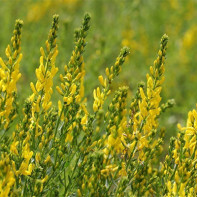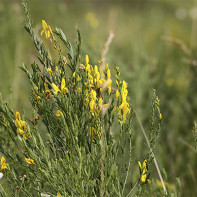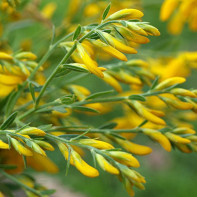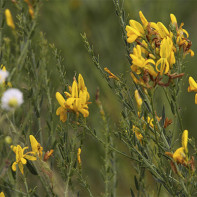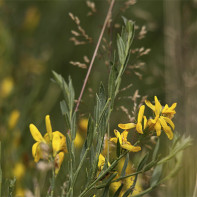Herb dye: medicinal properties and contraindications
Crocus dye is a widespread representative of the Legume family on the Eurasian continent. This is a famous weed, which is very much in demand in agriculture. It is eaten by goats, cows, and poultry. It reproduces very well by self-seeding, so it is difficult to get rid of it if it is found in a garden plot. But there is no need to do this, because the plant has medicinal potential and can be used in the treatment of a variety of diseases.
- Chemical composition
- How it looks and where it grows
- Gathering and storage
- Useful properties of dyer's broomstick
- Dyer's broomstick in folk medicine
- For joint treatment
- For cystitis
- With prostatitis
- A universal analgesic
- Otitis
- Skin Care
- Medication for obesity
- For Women's Health
- For Diabetes
- Healing Compounds
- Infusion
- Infusion
- Decoction
- Contraindications to use
Chemical Composition
Science has relatively recently become interested in this plant, because there have been recorded cases of therapeutic effectiveness of extracts in the treatment of thyroid diseases. Large-scale studies began, and during the chemical analysis of different parts of the plant, scientists were able to find out what substances are included in its composition.
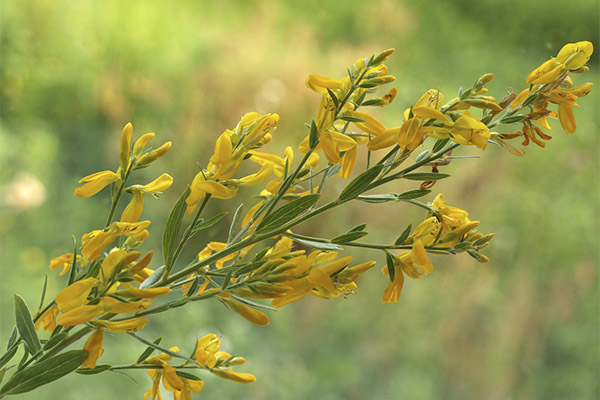
- Essential oils from 0,02 to 0,05 %. The highest concentration is found in dried inflorescences.
- Alkaloids: ormosanine, cytisine, anatabine, nufaridine, sparteine. The plant also contains unknown to science substances from this group, so it is considered poisonous. The highest concentration of toxic alkaloids with unexplored structure is in the seeds.
- Resinous substances, including resin acids (succinic acid, which is famous for its antioxidant effect, pimar and abietic acid).
- Triterpene and steroid saponins, which normalize the hormonal background, affect the functioning of the endocrine system, stimulate the production of insulin in the body.
- Mineral salts of over 10 kinds necessary for the normal functioning of the cardiovascular system and kidneys, maintaining water-salt balance and brain function.
- Organic acids of at least 8 kinds, affecting various functions in the body.
- Glycosides involved in metabolic processes, improving the transport capacity of blood cells, increasing the level of vital energy.
- Tannins, which have antibacterial and wound healing properties.
- Bitterness are natural components that stimulate the secretion of bile and the production of digestive enzymes. They are also important for a healthy metabolism and maintaining normal blood sugar levels.
- Antioxidants are substances that neutralize free radicals, slow down the aging process, regenerate cells and protect against cancer.
- Compounds of potassium, silicon, phosphorus, calcium, barium, iron and manganese.
In addition, the inflorescences of the plant have two kinds of organic pigments - genistein and luteolin. Additionally in the flowers and roots there are substances that are poorly understood. Their effect on the body is unknown, so treat with yeast dye should be careful not to exceed the recommended dosage.
How it looks and where it grows
Dyer's broom is a very common herb that is often found in the wild in Western Siberia, in the European part of Russia, in Ukraine, Belarus, Poland, Bulgaria, in many Asian countries. The flower prefers well-drained soils with an alkaline reaction. Often found in meadows, on hillsides, in forests and brushwood.
To be able to distinguish Dyer's broom from other plants, you need to know what it looks like. Here are the basic botanical characteristics:
- The minimum height is 40-50 cm, and the maximum - up to 1.5 m.
- The stems are branched, not covered with foliage.
- Leaves are small, lanceolate or linear with a deep green color, which retains its brightness even after drying.
- Inflorescences are brush-shaped, consisting of numerous small bright yellow flowers.
- The fruits are curved pods with bean-shaped, rounded seeds of a brownish hue, oval or elliptical in shape.
It is important to have time to harvest the inflorescences before the seeds begin to form and ripen. The problem is that they contain a concentration of toxic substances that may have a negative effect on health.
Harvesting and storage
Dyer's broom is not included in the pharmacopoeia, so it is impossible to buy it in regular pharmacy chains. It is better to be engaged in the collection and harvesting of raw materials on their own, the more so it is not difficult at all. Herb dye grows on almost every vacant lot and field, it is only necessary to go out of town, find a more or less environmentally friendly place where you can safely collect raw plant material. Nearby there should not be plants and factories, all sorts of farms, sewage treatment plants and highways. Also, the area must have a normal radiation background.
Almost all parts of the plant are suitable for use as medicinal raw materials. But there are peculiarities of collecting and harvesting each of them.
- The peak of flowering of dye yeast is the second half of June and July, during this time you need to have time to cut the inflorescences and dry them. Store in cardboard, glass or metal containers.
- At the same time you can also collect the leaves - the entire above-ground part of the dyer's broomstick is used in alternative medicine. They should be dried in the shade, and then packed in a container that is hermetically sealed.
- If you need to harvest the rhizome for decoctions and tinctures, you need to go get it in the second half of September. Dig up the underground part of the plant, shake off the ground and dry in an oven (or a dryer) at 45-50 degrees. Pack the finished, completely dry raw material in cloth bags or cardboard boxes.
Store all the harvested raw materials can be no longer than 1 year, that is, every season you need to collect a new crop of medicinal herbs. Such a period of storage is relevant only if the rules are followed. It is necessary to maintain in the room where herbs are stored, optimal humidity. Temperature - a secondary issue, but it is important that there were no sudden changes. If the raw material is covered with mold - it means that it was badly dried or the reason is in improper storage conditions. It is strictly forbidden to use it.
Useful properties of dyer's broom

Due to the presence of medicinal potential, the plant can bring health benefits. Its composition provides such pharmacological properties:
- antibacterial;
- antiviral;
- styptic;
- diuretic;
- anti-inflammatory;
- wound-healing;
- laxative;
- analgesic and antispasmodic;
- vasodilator;
- anti-coughing.
The rich composition of this plant allows it to be used as a therapeutic agent. Traditional medicine has not yet recognized Dyer's broom, but this has not stopped many generations from using its power to treat such ailments:
- cystitis, nephritis and urological infections;
- migraines, headaches, hypotension;
- prostatitis, urethritis, urinary tract infections;
- festering ulcers, boils;
- acne, seborrhea;
- Pain syndrome of any localization;
- Rheumatism, arthritis, arthrosis;
- cholecystitis, early stage of cholelithiasis;
- urolithiasis;
- inflammation of the sciatic nerve;
- urolithiasis;
- Acute respiratory infections, influenza, respiratory tract infections;
- Purulent otitis, cholesteatoma.
The possibility of using extracts of dyer's broom for a particular disease should first of all be discussed with your doctor. It is ideal to find an herbalist and ask them to work out the best course and dosage. This is very important in the case of using the plant in question for one reason only - it is toxic. It is necessary to soberly weigh the ratio of potential benefits and risks.
Dyer's broom in folk medicine
The plant has been used for quite a long time, so in alternative medicine formed clear rules for the use of dye's broomstick, recipes, combinations with other herbs. Described below are ways of treating various diseases with this herb.
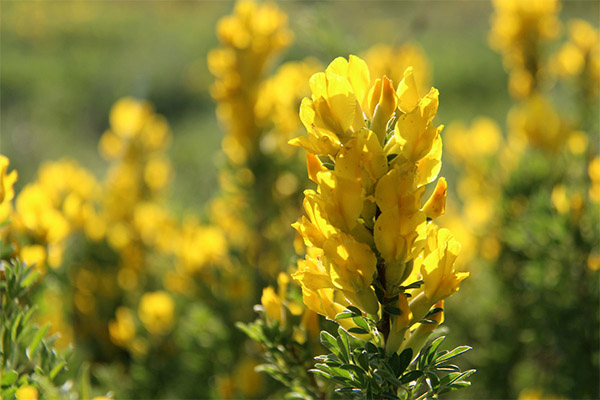
To treat joints
If the joints are inflamed, their mobility is impaired, there are painful sensations, a tincture or ointment of dye-grass can help. Tincture should be prepared according to the classic recipe - from the flowers or root, to use for daily rubbing - 2 times a day with an aggravation. You can also make compresses - overnight tie painful joints with a cloth soaked in tincture and cover the top with food wrap.
The ointment is used externally for rubbing in pain and inflammation. You need to take pig fat (200 g), melt in a steam bath and pour there 3 tablespoons of dried inflorescences of dyer's broom. Boil for 30 minutes, strain and drain into a clean jar. Rub into sore spots 2-3 times a day or use under a compress at night.
For cystitis.
Urological infections can cause discomfort. Frequent and unproductive urges to urinate, lower abdominal pain and rubs, and fever are typical signs of cystitis. Do not hope that it will pass on its own, since the infection can spread to nearby organs or pass on to the kidneys.
If you do not want to use an antibiotic, you can replace it with a safe natural remedy that is prepared using the plant in question. To create a multi-component medicine, you need to take in equal parts such herbs:
- Crocus medicinalis;
- hop cones;
- oregano;
- yarrow.
1 tbsp. Brew a glass of steep boiling water, steep for 1 hour. Drink 1 tbsp. 4-5 times a day with a cup of warm boiled water. Additionally, to relieve pain and inflammation, you can take a bath of decoction of dye yeast.
If you have prostatitis
Prostatitis can be difficult to treat if only herbal remedies are used. There is no need to abandon traditional medications, phytotherapy will only increase their effectiveness. With prostate inflammation, the main cause is usually a urological infection. If the diseases of the urogenital system are not treated, they can become chronic in nature. As a result, in case of hypothermia or after experiencing stress, the prostate gland will be attacked by pathogens. Then this recipe will come to the rescue:
- 10 g of the inflorescences of dyer's hornwort;
- 5 g field horsetail;
- 5 g bearberry;
- 600 ml of water.
You need to brew the herbal collection in a thermos, steep boiling water, and then leave it for 4-5 hours. Strain the medicine, take 50 ml in the morning and evening. It is important to do this before a meal, because additionally the herbal remedy stimulates the production of digestive enzymes, so it can cause a feeling of hunger and discomfort in the stomach.
Universal analgesic
For pain of various localizations, you can use the healing power of dyer's broomstick. This is an alcoholic tincture, it is prepared from 3 tbsp of herb and 100 ml of alcohol. You need to soak the medicine in a warm and dark place for 2 weeks, pour into a clean bottle. Take as an analgesic 20 drops on a sugar cube or diluted in a glass of cold boiled water.
In otitis media.
Purulent otitis media is dangerous for complications, so they must be treated immediately, without waiting for the inflammatory process to spread to the tissue of the auditory bones and the eardrum. For treatment and pain relief, you can use an alcoholic tincture of the medicinal plant Hoke. Literally 2-3 days destroys pathogenic microflora, blocks the inflammatory process. It is necessary to insist on medical alcohol (100 ml) 2 tbsp. flowers for 2 weeks. If there is a tendency to otitis, it is worth preparing a tincture in advance.
Before use, you need to clean the ears well, using cotton swabs soaked in hydrogen peroxide. Drop 1 drop of the tincture in each ear, even if only one ear is inflamed. Such a step will help prevent the infection from spreading. The procedure should be repeated 3-4 times a day. You can soak a cotton turunda in the tincture and place it in the sore ear before going to bed so that it does not hurt.
To treat skin
From sores and boils, allergic rashes, inflammatory processes and burns, you can use a water infusion of the plant. Application is only external, there is no point in drinking it, as it is the local effect that is important. Infusion for skin diseases is prepared according to a special recipe:
- 1 cup of herbs;
- 1 liter of water.
Infuse in a thermos and wrap the container with a warm towel to keep it hot as long as possible. After that, strain the infusion, use for compresses and rubbing the affected areas.
The cure for obesity
Quite a common problem is gaining excess weight due to changes in the hormonal background caused by endocrine disorders. In the long term, this can lead to severe complications and even shorten life expectancy. Standard remedies - diet, exercise - do not help. The problem is that they eliminate only for a short time the effects of the problem, but its cause remains and the weight returns with twice the force.
Drok dye helps to normalize the functioning of the endocrine system, restore hormonal balance, due to which the problem of obesity is eliminated. An aqueous infusion is used for treatment. It is necessary to brew 1 tsp. herb with a glass of water and divide it into two doses - to drink in the morning and in the evening. It is worth preparing for a long treatment if the body mass index is above 30. Take herbal medicine should not be longer than a month, then take a break for a couple of weeks and repeat until the hormonal background is normalized. It is also worth combining treatment with a low-calorie diet and sports.
For women's health
Inflammatory processes occurring in the organs of the reproductive system can lead to serious consequences. In the initial stages, it is possible to cope with diseases of the genitals without antibiotics and pharmaceuticals. Crocus dye is one of the most effective medicines used in gynecological practice. The plant can be used as part of complex therapy for such diagnoses:
- Inflammation of the Bartolin gland, abscesses and cysts;
- Vaginitis and vaginosis of bacterial etiology;
- candidiasis.
Infusion of inflorescences prepared according to the traditional recipe is used for douches, compresses and douches. It is also possible to use orally in the acute stage by 1 tbsp. decoction of the roots.
When diabetics.
Glycosides and some alkaloids, which are included in the composition, have the ability to reduce blood sugar. That is why the plant can be used as a means to stabilize glucose levels in diabetes, and it is effective both in the first and in the second type of the disease.
It is necessary to consult an endocrinologist and adhere to the doctor's recommendations. The medicine is prepared every day, as it is important to take just a fresh infusion. When it stands, the concentration of valuable glycosides is significantly reduced. Take 300 ml of water for 1 tbsp. of inflorescences, boil for 5 minutes and insist for 1 hour. Drink 100 ml 3 times a day.
Types of medicinal compositions
It is important to know the proportions and technology in making natural remedies yourself. There is nothing difficult about it, specialized equipment or pharmaceutical knowledge is not useful. But if you do not follow the recipe, the medicine can turn out useless or too concentrated and toxic.
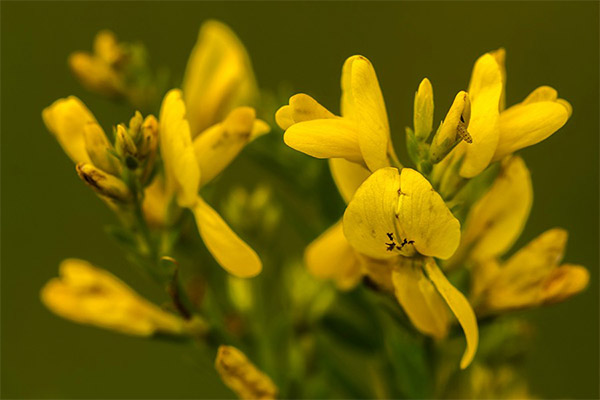
Infusion
With each individual diagnosis, the recipes for preparing medicines are different. But there are basic technologies for creating a universal potion. The traditional infusion recipe is as follows:
- Take 2 tbsp. mixture of herbs and inflorescences;
- pour 300 ml of boiling water;
- Infuse for 2 hours;
- strain.
The medicine turns out to be quite concentrated, so the maximum single dose is 1 tbsp. Take the infusion no more than 3 times a day, and no longer than 2 weeks.
Tincture .
Alcoholic tincture of dyer's broom can be carried instead of pain pills in case you have a headache, joints, teeth or other parts of the body. It can also be used for a course of treatment. Most often in the preparation of the alcoholic extract use the rhizome of the plant, but you can also take the inflorescences, the effectiveness is not less, just different proportions.
Ingredients for creating a medicine:
- 500 ml of vodka;
- 2 tbsp. crushed roots or ½ cup of dried inflorescences.
You need to take a clean and dry container, on the bottom lay the prepared herbal raw materials. Pour to the top of the vodka, close tightly sealed lid. Insist the remedy in the warmth, away from sunlight. After 3-4 days shake, then another week. On 10-14 days you can strain and filter the finished tincture. Store for 1 year. Single dose of 1 tsp.
Decoction .
Prepare the decoction can be the usual way - to boil the raw material in a pot of water, and then insist. But you can boil the medicine in a steam bath. This method is more suitable for making a decoction of inflorescences. You need to take 1 tbsp. Raw materials, pour 0.6 liters of boiling water, boil on a steam bath for 20-30 minutes to evaporate to a volume of 0.5 liters. Keep the finished product under a closed lid for about 40-50 minutes, strain and pour into a jar for storage. Single dose - 30-50 ml, no more.
You can prepare a decoction from the rhizome of the plant on the fire. You need to pour the raw material with cold water: 2 tbsp. of crushed root - 500 ml of liquid. Boil for 15 minutes, cover and leave until it cools. After that, drain the liquid into a clean container through a sieve, cover and send to the bottom shelf of the refrigerator. Drink 1 tbsp. 2-3 times a day.
Contraindications to use
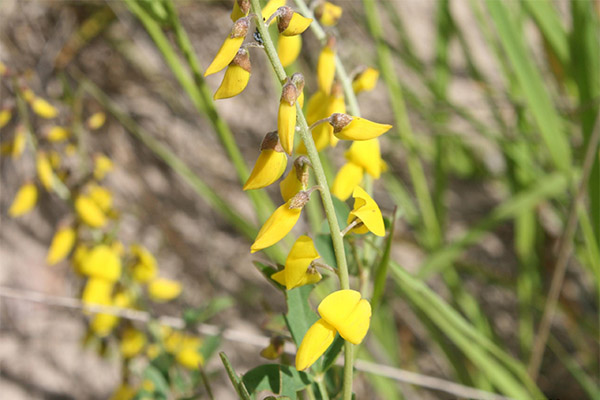
It is impossible to use the healing power of dyer's broom, if the body does not accept this medicinal plant. The main contraindication is an allergic reaction, individual hypersensitivity. But this is not the only reason to refuse treatment with the herb. It is also forbidden to use the plant for such problems and physiological conditions:
- pregnancy;
- Breastfeeding;
- Children under the age of 12 years;
- acute hepatitis;
- hypertension;
- heart failure.
Also with caution should be used medicines from this plant in hyperthyroidism. It is necessary to consult with a doctor and on the basis of the results of laboratory tests to decide on the advisability of using the herb, as well as to choose the optimal dosage and duration of the course.
It is important to understand - if the dosage is exceeded, from a useful medicine, extracts of dyer's hornwort turn into poison, which can cause damage to the liver, kidneys and nervous system. It is necessary to be able to recognize the symptoms of overdose in time:
- Dizziness;
- nausea;
- tremors in the extremities;
- vomiting;
- headaches;
- increased blood pressure;
- cold sweat;
- cyanosis (lividity of extremities, lips);
- arrhythmia.
If you or a loved one develops such symptoms during treatment, take a sorbent immediately and call an ambulance. If you do not hospitalize a person who has been poisoned by the toxins of broomstick, serious complications may develop.
Dyer's broom is a unique natural remedy for many ailments. It can raise blood pressure, help cope with inflammation and block the spread of infections. But it is also a source of toxins. By following the rules of application, you can use this herb for the benefit of the body!
«Important: All information on this site is provided for informational purposes only. purposes. Before applying any recommendations, consult a specialist. specialist. Neither the editors nor the authors are liable for any possible harm caused by materials."

